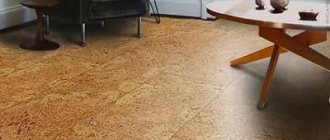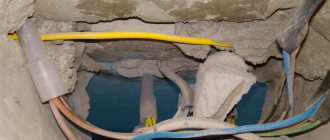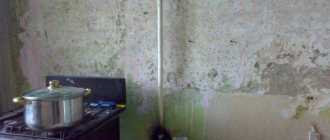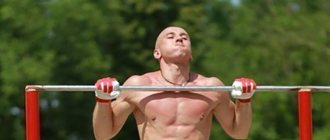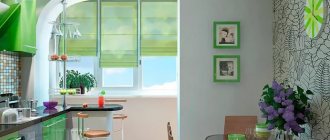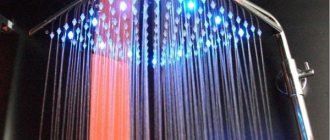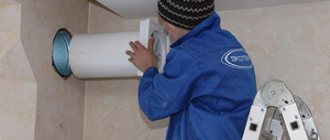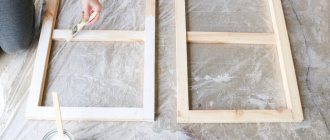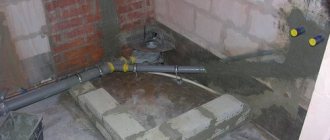You need to know this before repairing
How to fill the floor in an apartment Warm floor in an apartment: a modern choice How to change floors in Khrushchev, Stalin, Brezhnevka
In this article I want to share with you my personal experience regarding choosing flooring for an apartment. The main criterion that is important for you to consider is finances. I have come across situations where a customer dreamed of a beautiful and high-quality coating, but only had enough money for laminate. Therefore, I recommend making a realistic assessment of your capabilities.
Important
It is equally important to consider the number of floors of the apartment. I’ll explain why: if you live on the ground floor, then remember that there is an unheated basement below. This means increased humidity and cold. If you live on the second floor or higher, then below you there will be a residential heated and dry apartment.
When choosing a floor covering, I also recommend taking into account the height of the room. Some technologies are simply unrealistic to introduce into an apartment, for example, wooden floors on joists if the ceiling height is 220 cm. Another point is the difference in floors between rooms. We level the floors at all our facilities.
If your apartment has a wooden floor, then I do not recommend pouring a concrete screed. There will be a lot of stress on him. On the contrary, choose a coating that is light in weight, such as laminate or linoleum. Well, it’s also important to pay attention to aesthetics.
From a practical point of view, I also advise you to choose flooring by zone. For example, you can use tiles for the kitchen and bathroom; you can lay wood, laminate, and the like in the bedroom.
Advice
Zone the area. Separate it with color, it’s beautiful and convenient.
Here's what zoning floors look like:
Saving on the rough field
Often the cost of a solution must be considered in its entirety. You need to compare several lines in the estimate at once, and not just one. This way you can cover the floor with an inexpensive laminate. But the cost of m2 must include a subfloor (a strong and level base) and a substrate.
With wooden floors, there are other cost items: in addition to the boards, there is also oil or varnish, sealant or cork backing to protect against squeaks, and fasteners.
But the absence of a subfloor, the pie of which can cost a pretty penny, warms the soul.
Moisture-resistant plywood
Multilayer plywood has high mechanical strength and good thickness geometry. It can be laid on frame leveling joists. Many finishers lay it directly on concrete floors under parquet or laminate: the floor becomes warmer, but plywood does not solve the problem of sound insulation. This material is quite expensive, and many, trying to save money, take a non-moisture resistant brand. Such plywood (even without leaks) can begin to delaminate after just a few years. This material is not used in wet areas. Suitable for parquet, carpet and linoleum.
How to pull together boards
The easiest way is to cut a piece with a groove from the same board.
And use a hammer to adjust the boards to each other. But this method is not for perfectionists. If you have the opportunity and desire, then you can make one of the magical devices.
Device for pulling together boards
In this video, the author demonstrates the operation of this thing: https://www.youtube.com/watch?v=PMEzEffA2-U
Unfortunately, the author did not give the dimensions.
Second device
Andrey Shaiter is famous for his extremely useful videos. And then he turned up the heat. I assembled a device from plywood, tested it and already made a tool from a 25x25mm square aluminum pipe. All sizes are in the video.
A self-builder doesn’t need such thoroughness; it can be made from plywood. It won't be difficult to assemble a couple of these pieces.
In fairness, it is worth mentioning the device from Kreg. This dream of a perfectionist costs 6000 rubles. Ideal angles, drilling and tightening with stops will eliminate pinching and cracking. Suitable for cladding walls, terraces and of course floors.
Effective thermal insulation material
| Photo | Name | Rating | Price | |
| #1 | Extruded polystyrene foam | ⭐ 99 / 100 | More details | |
| #2 | Penolast | ⭐ 97 / 100 | More details | |
| #3 | Expanded clay | ⭐ 96 / 100 | More details | |
| #4 | Basalt wool | ⭐ 80 / 100 | More details |
In order to make the floors as warm as possible, it is important not to skip the thermal insulation stage. Expanded clay, basalt wool, and polystyrene foam are used as materials that help retain heat. Laying the material is simple - slabs or layers of any of them are mounted end-to-end, without gaps, on a surface insulated from water. In this way, it will be possible to obtain a base that maximally retains the heat that tends to leave the house.
Attention! After laying the insulation material, it is recommended to lay another layer of waterproofing. This will allow you to fill the screed evenly and protect the insulation as much as possible from getting wet in the event of flooding. Wet insulation often loses most of its properties.
Using polystyrene foam for floor insulation
Extruded polystyrene foam
The most convenient and simplest option is polystyrene foam. In addition to its thermal insulation functions, it makes floors stronger. It is obtained by mixing granulated polystyrene and a special foaming agent at high temperatures and created pressure, followed by extrusion from the extruder.
Extruded polystyrene foam
pros
- good thermal insulation;
- low water absorption rate;
- low vapor permeability;
- durability;
- ease of installation.
Minuses
- high price;
- flammable material.
Penoplex for floors
Styrofoam
Polystyrene foam can also be used as insulation. In this case, PSB50 grade material is used for garages and warehouses, and PSB35 is used for residential premises.
Brands and characteristics of foam
It is important to protect polystyrene foam from contact with cement, which can destroy the material. To do this, the foam must be covered with plastic film.
pros
- low cost;
- good thermal insulation;
- light weight;
- long service life;
- is not a medium for the development of microorganisms and fungi;
- ease of installation.
Minuses
- subject to mechanical damage;
- when burning, releases toxic substances;
- hygroscopic;
- afraid of sunlight;
- we love rodents;
- unstable to solvents.
Styrofoam
Expanded clay
This material consists of small granules with low mass, which is achieved thanks to the ubiquitous pores. Expanded clay is a heat insulator that meets environmental standards.
Expanded clay
pros
- environmentally friendly material;
- good heat and sound insulation properties;
- light weight;
- resistant to fire;
- long service life;
- easy installation.
Minuses
- a thick layer of insulation “eats” the height of the room.
expanded clay
Basalt wool
Basalt insulation (or rock wool) is an insulation based on ordinary mineral wool, but basalt rock is used as a filler.
Basalt wool
pros
- environmentally friendly material;
- excellent thermal insulation properties;
- non-flammability;
- durability;
- resistance to rodents and insects;
- easy installation.
Minuses
- tends to absorb moisture, which is why waterproofing measures must be carried out especially carefully.
stone wool
How to cover a wooden floor to avoid problems
In my opinion, varnish is not an option. If it peels off, as in the photo above, then you need to remove it from the entire surface and reapply it. This process is called scraping.
Trick: I recently began to remove a small chamfer from the floor board with a double-dome. After all, it is on the edges that chips occur. This way your floor will retain its original appearance longer.
The second reason is that the varnish makes the surface “plastic”. Yes, she looks like a tree. But to the touch and in essence it is acrylic. Then it’s better to buy laminate. He is more resistant to damage.
The only alternative to varnish may be oil. I like Russian. This is not an advertisement.
By the way, the guys from Doubledom also do not use varnish, but coat it in 2 layers with German Biofa borma or Osmo oil. Here is a comment from their leader:
Good oil costs about +200 rubles per m2. In the basic configuration of the house, the Tex water composition performed well.
Here are the floors in one of the Double Houses. This is not an oil or a varnish. This is Tex's water composition. The most budget option. Half a year old. But a Labrador weighing about 40 kg caused damage to him with its claws. Therefore, dog lovers need to take this experience into account.
Softness and comfort - cork tiles
If you like to walk barefoot around the house, then cork flooring is for you. It is soft and warm, and also has a pleasant design, it will be a pleasure to walk on it. Cork tiles are the cheapest and also the most natural type of flooring. The color scheme is varied, everyone can choose to their taste, or match it to their interior.
Benefits of the oil
They won’t describe the advantages here—you can find them online. Very briefly:
- the damaged area can be washed, sanded and re-oiled without redoing the entire floor
- the wood remains to the touch and looks like wood
- “Zhivitsa” is 100% natural. You can work without gloves and respiratory protection. Unless you are prone to allergies to anything and everything. The base is linseed oil. There are no strong odors during work. The oil is washed off in the usual way with soap.
Foundation preparation process
All work on arranging a rough screed begins with careful preparation of the soil base. To begin with, it is important to identify the highest and lowest points, taking into account the level of the soil and the evenness of its surface. A laser level will help determine their values. This procedure is necessary in order to evaluate for yourself the entire scope of work, as well as determine how much building materials may be required.
It is also important to pay attention to thoroughly compacting the soil. To do this, you can use special construction equipment - for example, a roller or vibrator. The procedure is necessary so that in the future the soil does not sag significantly and this does not lead to cracking of the rough screed, which will undoubtedly negatively affect the finishing floor covering.
Pneumatic rammer for soil compaction
After the soil has been thoroughly compacted, a sand and gravel cushion is laid. It can also be made of clean, washed and river sand. The thickness of this layer should not be more than 60 cm. In the latter case, a layer of gravel or expanded clay is also poured on top, which will make it possible to create a more durable base.
Attention! Before the soil is compacted, it is important to cut off the entire fertile layer, if any. It can be found in a more worthy use than burial under the house. The soil layer is removed approximately 35 cm.
It is also recommended to fill the pillow not all at once, but in layers - for example, 20 cm each. In this case, each layer is well compacted separately. The procedure will make the base as dense as possible. Before compacting, the pillow is moistened with water. The thickness of the expanded clay layer can be at least 10 cm. This layer is also compacted separately.
Expanded clay backfill
Prices for popular models of electric vibratory rammers
electric vibrating rammer
How to properly coat a spruce or pine board with oil
The floorboard is usually made of softwood. This means that it contains a lot of resin. The resin will prevent oil from penetrating into the pores. On his Instagram, the manufacturer gave a way to properly coat spruce and pine with oil.
Question: I heard that oil is of little use on spruce and pine . There, they say, the resin is in the pores and the oil does not penetrate. Are they lying? ) Tell me how to do it correctly. Are there any nuances or differences from hardwood? Manufacturer's response: Resinous rocks can be treated with gum turpentine before impregnation with oil and all resin pockets can be cleaned. After this, soak in oil. There will be no sense if you do NOT process it, especially such porous wood species)
True, they gave this feature in the context of wooden furniture. But the mechanics and process are the same.
Something else worth paying attention to is the polymerization time of the oil. The surface can be used after 1-2 days. But the final formation of the oil layer will occur after 21 days. Until then, it must be handled with care.
Self-adhesive PVC boards
People with creative potential and simply creative individuals will like these vinyl tiles. This coating is cheap and the main advantage is that the tiles have different colors, textures and designs. You can lay out the floor by combining different shades. By the way, in order to lay such a floor, you just need to peel off the protective layer from the tile and glue it to the right place.
The main rule for this coating is that before using it, be sure to wash and dry the floor.
How to coat with oil and what consumption?
From one site we managed to get as many as 4 combinations of applying Zhivitsa oil to a wooden floor.
In any case, it would be a good idea to contact the manufacturer. And discuss the scheme and nuances of the coating. They actively respond to email and Instagram. And they definitely have the latest information.
The first combination is oils from the “Standard” line
- 1st layer - Primer oil. Antiseptic (consumption 10-15 m2 per 1 liter of oil);
- 2nd layer – Solid oil with wax (consumption 15-20 m2 per 1 liter of oil);
- 3rd layer – Solid oil with wax (consumption 22-25 m2 per 1 liter of oil*);
- 4th layer – Carnauba wax (consumption 15-20 m2 per 1 piece).
The second combination is professional oils from the “Pro” line:
- 1st layer - Bio Soil (consumption 10-15 m2 per 1 liter of oil);
- 2nd layer – Parquet (consumption 15-20 m2 per 1 liter of oil);
- 3rd layer – Parquet (consumption 20-25 m2 per 1 liter of oil*).
The third combination is oils from the “Standard” “Pro” line:
- 1st layer - Primer oil. Antiseptic (consumption 10-15 m2 per 1 liter of oil);
- 2nd layer – Parquet (consumption 15-20 m2 per 1 liter of oil);
- 3rd layer – Parquet (consumption 20-25 m2 per 1 liter of oil*).
The fourth combination is also “Standard” and “Pro” oils
- 1st layer - Bio Soil (consumption 10-15 m2 per 1 liter of oil)
- 2nd layer – Solid oil with wax (consumption 15-20 m2 per 1 liter of oil)
- 3rd layer – Parquet (consumption 20-25 m2 per 1 liter of oil*)
* Oil consumption for hard wood will be less.
Economical carpets
If you really really want a soft carpet https://comfort-room.com.ua/ under your feet, then you need to purposefully look for something cheaper, there are always options. It goes without saying that you can always count on a discount if you decide to install such a floor throughout the entire house and plan to cover a large area. And if you just need to hide a problem area in a certain area of your home, without replacing the entire floor, a small carpet is also a good solution.
Carpet
The same story as with tiles - there are a huge variety of coatings on the market, which you can’t figure out without a consultant: which fabric accumulates static electricity and which does not, how the coatings differ in the manufacturing method, how wear-resistant they are, whether they cause allergies... In general, not It’s immediately clear how justified the savings are.
The cheapest carpet is thin, made of polypropylene or olefin, without additional processing. The most expensive is on a woven jute base, with natural wool pile. The truth we are looking for is somewhere in the middle: truly affordable, and at the same time high-quality carpets are made by needlepunching or flocking; their pile, as a rule, is made of pure polyamide or in combination with wool and acrylic. It can be of different heights, but without synthetic shine, soft and uniform. Special treatment eliminates the problem of the electrostatic field.
What's good:
You should clean the bedroom carpet (especially if you don’t eat there or wear outdoor shoes) no more often than you should wash the kitchen floor. The pile does not emit volatile substances, which means that in the absence of dust, allergy sufferers can sleep peacefully. Good sound insulation, warmth, a cozy look and a variety of colors are a wonderful investment, say, in renovating an apartment with cold floors or noisy neighbors.
What to fear:
almost nothing. Bright coatings may fade in direct sunlight - and not all of them. Carpet is sensitive to moisture. And it’s better to get the most reliable vacuum cleaner.
Trending:
The most popular variety is carpet tiles in bright colors. In addition, carpet with a woven texture fits well in “ecological” interiors. Choose lush pile in pastel colors with a relief pattern for bedrooms and children's rooms in a nostalgic style. But velvety coverings with low pile in signal shades are suitable for modern minimalist interiors.
First floor in a private house
Floor pie on the first floor
Consider the following example of a design for the first floor in a wooden house. It does not use logs, and the sheathing is installed directly on the floor beams. This allows you to save ceiling height, makes the scheme simpler and cheaper.
The floor pie of the first floor in a wooden house is shown in the photo.
This scheme is suitable for the first floor above a warm basement, and for floors between the 1st and 2nd floors.
- At the very bottom there are cranial blocks made of 100*25 mm boards. They are screwed to the beams from the bottom. They are needed to construct a subfloor for laying insulation.
- Then there are load-bearing beams 200*50 mm.
- The subfloor made of 100*25 mm boards is laid on cranial blocks.
- A windproof film (vapor barrier membrane) is laid on the subfloor.
- Then insulation is placed between the joists. In a specific example, 2 layers of Rockwool Light Butts mineral wool are used, laid staggered, with a total layer thickness of 20 cm.
- The top of the insulation is covered with a vapor barrier.
- Then the sheathing of the joists is done. In this case, FSF plywood with a thickness of 21 mm is used. It is laid with offset joints.
- Additionally, it is recommended to add counter battens to this scheme to create a gap under the plywood.
Content
That is, in addition to strength, it must protect the apartment from extraneous sounds and foreign climates. It is the finished, well-executed floor that gives the apartment ensemble completeness.
Installing a floor is not a cheap undertaking. However, the variety of materials and methods of its construction allows you to build a fairly comfortable and aesthetic floor based on the most modest budget.
Thus, the floor in the apartment bears the following functional loads, which must be taken into account when installing it:
- Carrier.
- Warming.
- Soundproofing.
- Moisture-proof.
- Aesthetic.
Creation
Floor screeding is not difficult to do. But beginners have difficulties. Regardless of the type, it is necessary to prepare a rough foundation. You should get rid of various debris. Seal various cracks and gaps with sealant and cement mortar after priming. To avoid too much consumption and improve clutch performance.
To create you should:
-prepare various equipment: level, slats, mixtures, sand, etc.;
- markings are made;
- beacons are being installed;
- the mortar is being prepared;
- the rule is to level the solution.
Cork (from 60 rubles per square meter)
— Cork is perhaps the most human-friendly flooring material. It is soft, warm, shock-absorbing, hypoallergenic, environmentally friendly, and absorbs sounds well. Also, during the process of collecting cork, the tree does not die; after 8-10 years it will completely recover and produce a new harvest - and so on for 10-12 cycles. Moreover, even if something heavy stood on it, two or three weeks after the rearrangement, the marks formed under the influence of the weight are leveled out. In a word, cork is simply ideal for a private area where there is no moisture and heavy objects being dragged back and forth. But it also has its own specifics, warn the Trio. — If you have large pets that like to run around the apartment, the cork may not survive this. We are, of course, not talking about cats, who do not react in any way to such a floor covering, but about large dogs, braking with their claws on the floor - if they “skid”, they will simply break the plug, and you can’t do anything with it.
Belarusians are still wary of such floor coverings. Those who decide to buy are mainly those who vacationed in the European Mediterranean and, by renting housing, experienced all its advantages. The rest prefer something more familiar.
— When choosing cork, you need to understand that, unlike wood, it cannot be fully restored. Unfortunately, there is nothing to sand and coat with oil. And if the coating is seriously damaged, it will have to be replaced. Yes, there are repair kits, but they are designed mainly for thin scratches and nicks. If the damage is large, it will remain noticeable after treatment with special wax.
Also, the obvious advantages of cork are reduced if we are talking not about a natural surface pattern, but about a printed version. That is, some fashionable design is applied to natural cork, the whole thing is covered with hard varnish, and... that’s it. You won’t get those tactile sensations that you had, unfortunately.
The cork can be either locking or adhesive. Despite the seemingly lower cost of the latter option, if you add up all the costs for glue, varnish, and labor, in the end it will work out that way. Therefore, it is worth considering whether the hassle with the adhesive option is necessary or whether everything can be made simpler, warns the specialist.
It’s also worth mentioning that adhesive cork doesn’t care about moisture (it’s a cork), so it’s warm and soft and can be used even in bathrooms (on extremely flat surfaces - such that $100 would not normally fit). It’s better not to experiment like this with the interlocking board: the HDF plate that lies at the base will definitely react. And you won't like it.
Regarding installation: the locking plug can be “landed” directly on the screed without a backing, but it is still better to provide an “intermediary” two millimeters thick - it won’t be any worse, and the neighbors will clearly appreciate it.
General information
All produced plywood can be divided into five main varieties:
- Elite (marking E) – the best quality of the surface of the plywood sheet, has no defects.
- Small cracks , holes from small knots, patches from veneer - plywood of this type can be classified as grades 1, 2 and 3.
- Grade 4 plywood is often used only for concreting, as well as creating formwork, making a rough covering for the finishing floor. Despite the fact that the appearance of the material is unattractive, the quality characteristics of grade 4 plywood boards are no worse than first grade plywood.
In addition, you should consider in advance another quite important parameter in the characteristics of plywood sheets as a building material, namely surface grinding.
Wet screed
Wet screed is the most popular type, which is most often used in construction. In addition, such a screed is also called concrete or cement. It is made from cement to which various fillers are added. It is necessary to make a layer of 3 cm or more. There are minor disadvantages to this screed. Because it takes a long time to dry. And it exerts impressive pressure due to weight. Therefore, it is not suitable for all types of buildings. But, if made from high-quality materials, it is very reliable and will last a long time. The cost is low, so it is mostly made.
